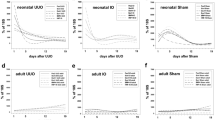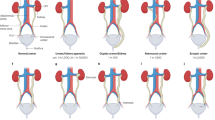Abstract
Removal of toxic substances from the blood depends on patent connections between the kidney, ureters and bladder that are established when the ureter is transposed from its original insertion site in the male genital tract to the bladder. This transposition is thought to occur as the trigone forms from the common nephric duct and incorporates into the bladder. Here we re-examine this model in the context of normal and abnormal development. We show that the common nephric duct does not differentiate into the trigone but instead undergoes apoptosis, a crucial step for ureter transposition controlled by vitamin A–induced signals from the primitive bladder. Ureter abnormalities occur in 1–2% of the human population and can cause obstruction and end-stage renal disease. These studies provide an explanation for ureter defects underlying some forms of obstruction in humans and redefine the current model of ureter maturation.
This is a preview of subscription content, access via your institution
Access options
Subscribe to this journal
Receive 12 print issues and online access
$209.00 per year
only $17.42 per issue
Buy this article
- Purchase on SpringerLink
- Instant access to full article PDF
Prices may be subject to local taxes which are calculated during checkout







Similar content being viewed by others
References
Tanagho, E.A. Development of the Ureter (Springer, New York, 1981).
Meyer, R. Normal and abnormal development of the ureter in the human embryo-a mechanistic consideration. Anat. Rec. 68, 355–371 (1946).
Hutch, J.A. Anatomy and Physiology of the Bladder, Trigone and Urethra (Butterworth's Appleton-Century-Crofts, London, New York, 1972).
Wilson, J.G. & Warkany, J. Malformations in the genito-urinary tract induced by maternal vitamin A deficiency in the rat. Am. J. Anat. 83, 357–407 (1948).
Kastner, P., Mark, M. & Chambon, P. Nonsteroid nuclear receptors: what are genetic studies telling us about their role in real life? Cell 83, 859–869 (1995).
Mangelsdorf, D.J. et al. The nuclear receptor superfamily: the second decade. Cell 83, 835–839 (1995).
Duester, G., Mic, F.A. & Molotkov, A. Cytosolic retinoid dehydrogenases govern ubiquitous metabolism of retinol to retinaldehyde followed by tissue-specific metabolism to retinoic acid. Chem. Biol. Interact. 143–144, 201–210 (2003).
Napoli, J.L. Retinoic acid: its biosynthesis and metabolism. Prog. Nucleic Acid Res. Mol. Biol. 63, 139–188 (1999).
Batourina, E. et al. Distal ureter morphogenesis depends on epithelial cell remodeling mediated by vitamin A and Ret. Nat. Genet. 32, 109–115 (2002).
Srinivas, S. et al. Expression of green fluorescent protein in the ureteric bud of transgenic mice: a new tool for the analysis of ureteric bud morphogenesis. Dev. Genet. 24, 241–251 (1999).
Yu, J., Carroll, T.J. & McMahon, A.P. Sonic hedgehog regulates proliferation and differentiation of mesenchymal cells in the mouse metanephric kidney. Development 129, 5301–5312 (2002).
Soriano, P. Generalized lacZ expression with the ROSA26 Cre reporter strain. Nat. Genet. 21, 70–71 (1999).
Yucel, S. & Baskin, L.S. An anatomical description of the male and female urethral sphincter complex. J. Urol. 171, 1890–1897 (2004).
Bok, G. & Drews, U. The role of the Wolffian ducts in the formation of the sinus vagina: an organ culture study. J. Embryol. Exp. Morphol. 73, 275–295 (1983).
Mauch, R.B., Thiedemann, K.U. & Drews, U. The vagina is formed by downgrowth of Wolffian and Mullerian ducts. Graphical reconstructions from normal and Tfm mouse embryos. Anat. Embryol. (Berl.) 172, 75–87 (1985).
Watanabe, T. & Costantini, F. Real-time analysis of ureteric bud branching morphogenesis in vitro . Dev. Biol. 271, 98–108 (2004).
Niederreither, K., McCaffery, P., Drager, U.C., Chambon, P. & Dolle, P. Restricted expression and retinoic acid-induced downregulation of the retinaldehyde dehydrogenase type 2 (RALDH-2) gene during mouse development. Mech. Dev. 62, 67–78 (1997).
Dickman, E.D., Thaller, C. & Smith, S.M. Temporally-regulated retinoic acid depletion produces specific neural crest, ocular and nervous system defects. Development 124, 3111–3121 (1997).
Niederreither, K., Subbarayan, V., Dolle, P. & Chambon, P. Embryonic retinoic acid synthesis is essential for early mouse post-implantation development. Nat. Genet. 21, 444–448 (1999).
Mic, F.A., Haselbeck, R.J., Cuenca, A.E. & Duester, G. Novel retinoic acid generating activities in the neural tube and heart identified by conditional rescue of Raldh2 null mutant mice. Development 129, 2271–2282 (2002).
Mendelsohn, C. et al. Function of the retinoic acid receptors (RARs) during development (II). Multiple abnormalities at various stages of organogenesis in RAR double mutants. Development 120, 2749–2771 (1994).
Stephens, F.D. Congenital Malformations of the Urinary Tract (Praeger, New York, 1983).
Mackie, G.G. & Stephens, F.D. Duplex kidneys: a correlation of renal dysplasia with position of the ureteral orifice. J. Urol. 114, 274–280 (1975).
Thomas, J.C., Demarco, R.T. & Pope, J.C. Molecular biology of ureteral bud and trigonal development. Curr. Urol. Rep. 6, 146–151 (2005).
Kochhar, D.M., Jiang, H., Penner, J.D., Beard, R.L. & Chandraratna, A.S. Differential teratogenic response of mouse embryos to receptor selective analogs of retinoic acid. Chem. Biol. Interact. 100, 1–12 (1996).
Willhite, C.C., Lovey, A. & Eckhoff, C. Distribution, teratogenicity, and embryonic delivered dose of retinoid ro 23–9223. Toxicol. Appl. Pharmacol. 164, 171–175 (2000).
Yasuda, Y. et al. Developmental anomalies induced by all-trans retinoic acid in fetal mice: I. Macroscopic findings. Teratology 34, 37–49 (1986).
Shakya, R., Watanabe, T. & Costantini, F. The role of GDNF/Ret signaling in ureteric bud cell fate and branching morphogenesis. Dev. Cell 8, 65–74 (2005).
Basson, M.A. et al. Sprouty1 is a critical regulator of GDNF/RET-mediated kidney induction. Dev. Cell 8, 229–239 (2005).
Grieshammer, U. et al. SLIT2-mediated ROBO2 signaling restricts kidney induction to a single site. Dev. Cell 6, 709–717 (2004).
Kume, T., Deng, K. & Hogan, B.L. Murine forkhead/winged helix genes Foxc1 (Mf1) and Foxc2 (Mfh1) are required for the early organogenesis of the kidney and urinary tract. Development 127, 1387–1395 (2000).
Brophy, P.D., Ostrom, L., Lang, K.M. & Dressler, G.R. Regulation of ureteric bud outgrowth by Pax2-dependent activation of the glial derived neurotrophic factor gene. Development 128, 4747–4756 (2001).
Yu, O.H., Murawski, I.J., Myburgh, D.B. & Gupta, I.R. Overexpression of RET leads to vesicoureteric reflux in mice. Am. J. Physiol. Renal Physiol. 287, F1123–F1130 (2004).
Miyazaki, Y., Oshima, K., Fogo, A., Hogan, B.L. & Ichikawa, I. Bone morphogenetic protein 4 regulates the budding site and elongation of the mouse ureter. J. Clin. Invest. 105, 863–873 (2000).
Mendelsohn, C., Batourina, E., Fung, S., Gilbert, T. & Dodd, J. Stromal cells mediate retinoid-dependent functions essential for renal development. Development 126, 1139–1148 (1999).
Larsen, W.J., Sherman, L.S., Potter, S.S. & Scott, W.J. Human Embryology (Churchill Livingstone, New York, 2001).
Acknowledgements
We thank L. Spraggon, H. Sun, Q. Al-awqati, D. Herzlinger, K. Glassberg and F. Costantini for critical reading of the manuscript and discussions; P. Chambon and P. Dolle for the Raldh2 mutants; F. Costantini for the Hoxb7-Gfp line and for help with time-lapse experiments; and G. Cook for artwork. This work was supported by grants from the US National Institute of Diabetes and Digestive and Kidney Diseases to C.L.M. and A.P.M.
Author information
Authors and Affiliations
Corresponding author
Ethics declarations
Competing interests
The authors declare no competing financial interests.
Supplementary information
Supplementary Video 1
CND apoptosis is crucial for separation of the ureter orifice from the Wolffian duct. Ureter maturation visualized by time-lapse photography. E12 Hoxb7-Gfp urogenital blocks were cultured for 60h and photographed at 1-hour intervals with an automatic shutter. Digital jpg images were then converted to an MPEG movie. Note the presence of apoptotic cells that undergo shape changes in the CND prior to ureter transposition. (MOV 7127 kb)
Rights and permissions
About this article
Cite this article
Batourina, E., Tsai, S., Lambert, S. et al. Apoptosis induced by vitamin A signaling is crucial for connecting the ureters to the bladder. Nat Genet 37, 1082–1089 (2005). https://doi.org/10.1038/ng1645
Received:
Accepted:
Published:
Issue Date:
DOI: https://doi.org/10.1038/ng1645



